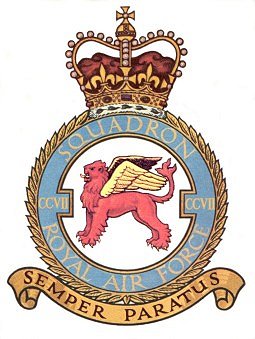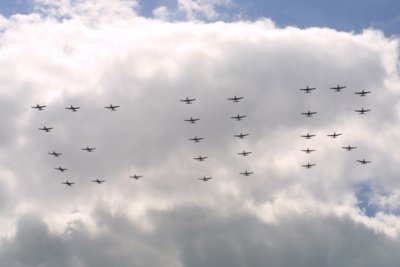207 SQUADRON ROYAL AIR FORCE HISTORY
When 207 Squadron 're-formed' at Linton-on-Ouse
207 badge Edward VIII
& George VI
We are sure that all associated with No.207 Squadron Royal Air Force or with No.7 Squadron Royal Naval Air Service will wish No.207 (Reserve) Squadron Royal Air Force a long, distinguished and successful life.207 Squadron RAF Association was delighted with the news that there would again be a 207 Squadron in the Royal Air Force. It was committed to forming close links with 207R and to pass on the distinguished and dearly bought 207 heritage, and the ethos that marked out the squadron from 1916 to 1984.
Ian Hampton, the Commanding Officer of 207 when it disbanded in 1984, was still a serving officer and looked forward to meeting his successor. There would be opportunities for the pilots of today's Royal Air Force training with the new 207(R) Squadron to meet the 207s of yesteryear.
All the former Commanding Officers of 207 who were members of the 207 Squadron RAF Association were informed.
207 (Reserve) SquadronWg Cdr Ken Marwood AFM RAF(Retd), President and Chairman of the Association together with them was amazed and hugely pleased that 207, which it was thought had gone forever, was to continue. It is very unusual for a squadron that has laid up its Standard after disbandment to be brought back to life. As Ken said "I'd love to meet the person who took the decision to award our number plate."
Squadon Leader Al Dolding RAF, Officer Commanding 207 (Reserve) Squadron, and Mrs Dolding, attended our 2002 Reunion at Derby on September 7th as our Guests of Honour. Before the AGM Sqn Ldr Dolding gave a presentation on the role of the Squadron.
Photos: 207(R) at work
Here are the announcements to date:
12 July 2002
RAF fast jet training Squadrons awarded Reserve Squadron numberplatesPersonnel and Training Command Press Release
The two Basic Fast Jet Training Squadrons at Number 1 Flying Training School (FTS), RAF Linton-on-Ouse near York, have been awarded reserve squadron status. The squadrons, which belong to Number 1 Flying Training School (FTS) fly the Tucano aircraft. They will be renamed Number 72 (Reserve) Squadron and Number 207 (Reserve) Squadron.
Number 1 Flying Training School, formed in 1919 and based at Linton since 1957, provided the aircraft for the recent 'EIIR' Jubilee flypast during the Queen's visit to the Armed Forces at Portsmouth. Nos 72 and 207 Squadrons were formed during the First World War and served with distinction for many years. No 207 Squadron originally formed as a Royal Naval Air Squadron and went on to fly as a Lancaster bomber unit. During the Second World War No 72 Squadron served as a Spitfire squadron in the Battle of Britain.
Group Captain David Harrison, from Headquarters Personnel and Training Command, said:
"The award of reserve squadron status is a considerable honour that will
serve to preserve the links of the present day RAF with its outstanding
heritage. The new status of the Linton Squadrons will also develop an
invaluable environment in which young student pilots can learn and
absorb the history, and reinforce the ethos, of the Royal Air Force."The inculcation of military ethos in all our trainees is essential in order to develop the esprit de corps required in a fighting force, and identity with specific squadrons has proved to be a powerful tool in the development of ethos for ab-initio aircrew.
All of the RAF's fast jet pilots undergo training at No 1 FTS on the Tucano aircraft and are presented with their 'wings' prior to further fast jet training on the Hawk at RAF Valley. In recognition of the pivotal role in the training of aircrew, the Air Force Board Standing Committee has granted the award of Reserve Squadron Status to 1 Squadron and 2 Squadron at No 1 FTS, Linton on Ouse; they will adopt the numberplates of Nos 72(R) and 207(R) Squadrons respectively.
With this award, all major flying training units in the RAF now have Reserve Squadron status. Aircrew trainees will therefore be immersed earlier in an environment that provides them with a rich history and a strong sense of attachment to the RAF and its ethos.
Squadron seniority is the guiding principle for the reactivation of dormant squadrons, although other factors such as a distinguished war record or a historic association with a specific role may also be considered. In this case, both squadrons were formed during the First World War and served with distinction for many years. Of note, No 207 Squadron originally formed as a Royal Naval Air Squadron, providing a welcome link to No 1 FTS's current role in training RN fast-jet pilots, and served with distinction with the Lancaster bomber during the Second World War. No 72 Squadron also has a distinguished war record, in particular having operated the Spitfire during the Battle of Britain.link to RAF website http://www.raf.mod.uk/history/linton.html
207 Squadron re-forms
(based on an article in RAF News 19 July 2002)The two training squadrons which provided the memorable E II R flypast for the Queen's Golden Jubilee visit to the armed forces have been awarded the 'number plates' of two famous squadrons.
Pilots and Tucanos from RAF Linton-on-Ouse based No.1 Flying Training School provided the 31 aircraft (pictured right).
It has been announced that the school's two basic fast-jet training squadrons are to be re-named 72(R) Squadron and 207(R) Squadron.
Both Squadrons have a distinguished history: 207 was a Lancaster unit in World War Two, 72 was a famous Battle of Britain fighter squadron and only disbanded in March this year after years flying the Wessex in Northern Ireland.
Award of reserve Squadron status follows a system based on squadron seniority. No.1 FTS trains around 120 students a year.
Links (no responsibility for the content of external websites):
207 (Reserve) Squadron website
http://www.raf.mod.uk/equipment/trainigaircraft.cfm Tucano aircraft
http://www.tgda.gov.uk/ 22 Group (Training)
visit the 207 bases page in Useful Links on the 207 website for information on RAF Linton-on-Ouse and a map



